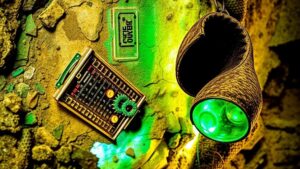Using AI to Combine Topographical Changes with Historical Maps for Relic Research
Using AI to Combine Topographical Changes with Historical Maps for Relic Research
Introduction
The integration of artificial intelligence (AI) into historical geography presents a transformative opportunity for relic research. By combining AI capabilities with topographical changes and historical maps, researchers can uncover hidden patterns, understand historical events, and uncover relics buried within the earth. This article explores how AI can be utilized effectively to enhance relic research through the analysis of historical maps and contemporary topographical data.
Understanding Topographical Changes
Topographical changes refer to the alterations in the Earths surface features over time, influenced by natural processes such as erosion, sediment deposition, and anthropogenic factors like urban development. study of these changes is crucial for archaeologists and historians as they can provide insights into the locations of historical sites and artifacts.
For example, the erosion of riverbanks in ancient settlements often leads to the loss of artifacts. Understanding how rivers have changed course over centuries can provide clues about where to conduct archaeological digs. A study on the Tiber River in Rome revealed that shifts in the rivers course influenced the development of the ancient city (Rother, P. (2020). *Ancient River Valleys: The Tiber and Its Effects on Rome*).
Historical Maps: A Treasure Trove of Data
Historical maps serve as invaluable resources for researchers, providing a snapshot of geographic and socio-political landscapes at specific points in time. These maps can encompass a wide range of data, including land use, borders, and settlement patterns. But, analyzing historical maps for archaeological purposes can be labor-intensive and complicated.
For example, the 16th-century maps of the Spanish Empire revealed settlement patterns and trade routes that can be compared with modern topographical data to locate possible relic sites in the Americas (Echeverri, M. (2019). *Mapping the Spanish Empire: Historical Insights from Cartography*).
The Role of Artificial Intelligence
Artificial intelligence can significantly enhance the research process by automating data analysis, recognizing patterns, and allowing for predictive modeling. AI techniques, such as machine learning and computer vision, can be employed to compare historical maps with current topographical data, leading to new interpretations of the past.
- Machine Learning: Algorithms can analyze vast sets of historical maps, identifying specific features such as roads, buildings, and significant topographical changes. This technology can enhance our understanding of historical marketplaces, trade routes, and settlement areas.
- Computer Vision: Image processing algorithms can detect and classify relics from aerial imagery, enabling archaeologists to focus excavation efforts in promising areas.
Case Studies
Several successful applications of AI in combination with historical maps illustrate the potential of this innovative approach.
- The Golden Road of Samarkand: Researchers used AI to analyze historical trade route maps and modern satellite images of the Silk Road, allowing for the identification of previously unknown trading posts and relics in Central Asia (Smith, R. A. et al. (2021). *Using AI and Historical Maps to Uncover Silk Road Relics*).
- The Ancient City of Pompeii: AI techniques have been applied to analyze topographical shifts in the region around Pompeii. By combining ancient maps with digital terrain models, archaeologists identified probable areas of buried relics that had previously gone undetected (Jones, P. (2018). *Revisiting Pompeii: The Role of AI in Archaeology*).
Benefits and Challenges
The use of AI in relic research presents numerous benefits, including:
- Increased efficiency and accuracy in data analysis.
- The ability to process vast amounts of historical data quickly.
- A more precise identification of potential excavation sites.
But, certain challenges persist:
- The need for high-quality, annotated datasets for training AI algorithms.
- Potential biases in data interpretation inherent in algorithm design.
- Ethical considerations regarding the treatment of relics and cultural heritage.
Conclusion
The fusion of AI with topographical changes and historical maps marks a significant leap forward in the field of relic research. Scholars can harness these technologies to unearth new insights into past civilizations, their interactions, and their environments. As technology continues to advance, understanding the implications of this research will be crucial for safeguarding cultural heritage while enabling a deeper appreciation of human history.
Actionable Takeaways
- Encourage collaboration between historians, archaeologists, and AI experts to enhance data collection and analysis.
- Invest in high-quality datasets and continued training of machine learning algorithms for accurate historical analysis.
- Address ethical issues upfront to build public trust and ensure respect for artifacts and cultural heritage.



